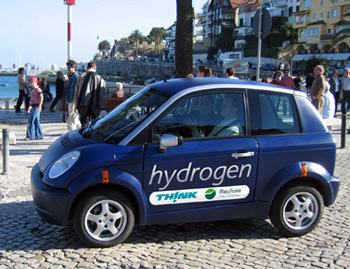Whatever Happened to the Hydrogen Car? New Findings from MIT Could Get the Wheels Turning Once Again
Posted by erik devaney
Courtesy of gasdetection.com
A few years back, hydrogen-powered cars seemed to be on a level playing field with electric cars. Car manufacturers were talking about hydrogen power, the Discovery Channel was airing shows about hydrogen power and then, poof! Hydrogen power left the world’s collective conscience and electric power became the latest and greatest thing to happen to cars since Henry Ford unveiled his Model T. Now it’s “Nissan Leaf this” and “Tesla Roadster that.” Did everybody forget about hydrogen?
No, not everybody. Professor of Nuclear Science and Engineering at MIT, Sow-Hsin Chen, recently led a study that promises to revolutionize how hydrogen is stored. The new hydrogen storage systems that are created using Chen’s findings could be vital to making hydrogen-powered cars both practical and affordable.
Scientists have long considered hydrogen to be a viable and environmentally friendlier alternative to fossil fuels. After all, when hydrogen is broken down to generate power, water vapors are the only emissions. However, when it comes storing hydrogen, which has tiny atoms that can escape from most containers, scientists have often struggled.
Current storage approaches — like liquefying hydrogen and storing it at subzero temperatures or storing gaseous hydrogen under extreme amounts of pressure — are expensive and largely impractical for use in vehicles. Chen and his team of researchers have a solution: store hydrogen atoms within activated carbon (a very porous, sponge-like substance), using platinum as a catalyst. This proposed storage system is lighter, safer and less expensive than any system in existence today.

Professor Sow-Hsin Chen
The real breakthrough underlying this new storage system was proving that hydrogen moves into porous materials, like activated carbon, as a result of the spillover effect. During the spillover effect, hydrogen atoms react to the platinum catalyst and break away from their molecules. They then diffuse through the activated carbon and bond to its surface.
“When you break the hydrogen molecules down to atoms it binds with the material with much less binding energy, so you can pump it out easily,” said Chen. This is an important consideration when storing hydrogen, because if the binding energy is too strong, the hydrogen will remain stuck. As Chen commented “You have to be able to pump the gas in and release it when you need it to burn.”
The next step for Chen and his team is to fine-tune the sizes and concentrations of the activated carbon and platinum to maximize storage capacity. Further on down the road, the researchers also want to find a catalyst that is less expensive and more widely available than platinum.
Related posts:
- Hub On Wheels Slated for Sept. 25; Sign Up Here
- Carbon Day Brings Electric Vehicles to Copley Plaza
- Ditch Your Wheels This Week and Enter to Win Hundreds of Dollars during Car-Free Week
- Check Out MIT’s 2011 List Of Top Innovators Under 35; Who in Boston Made the Cut
Short URL: http://www.newenglandpost.com/?p=4170








